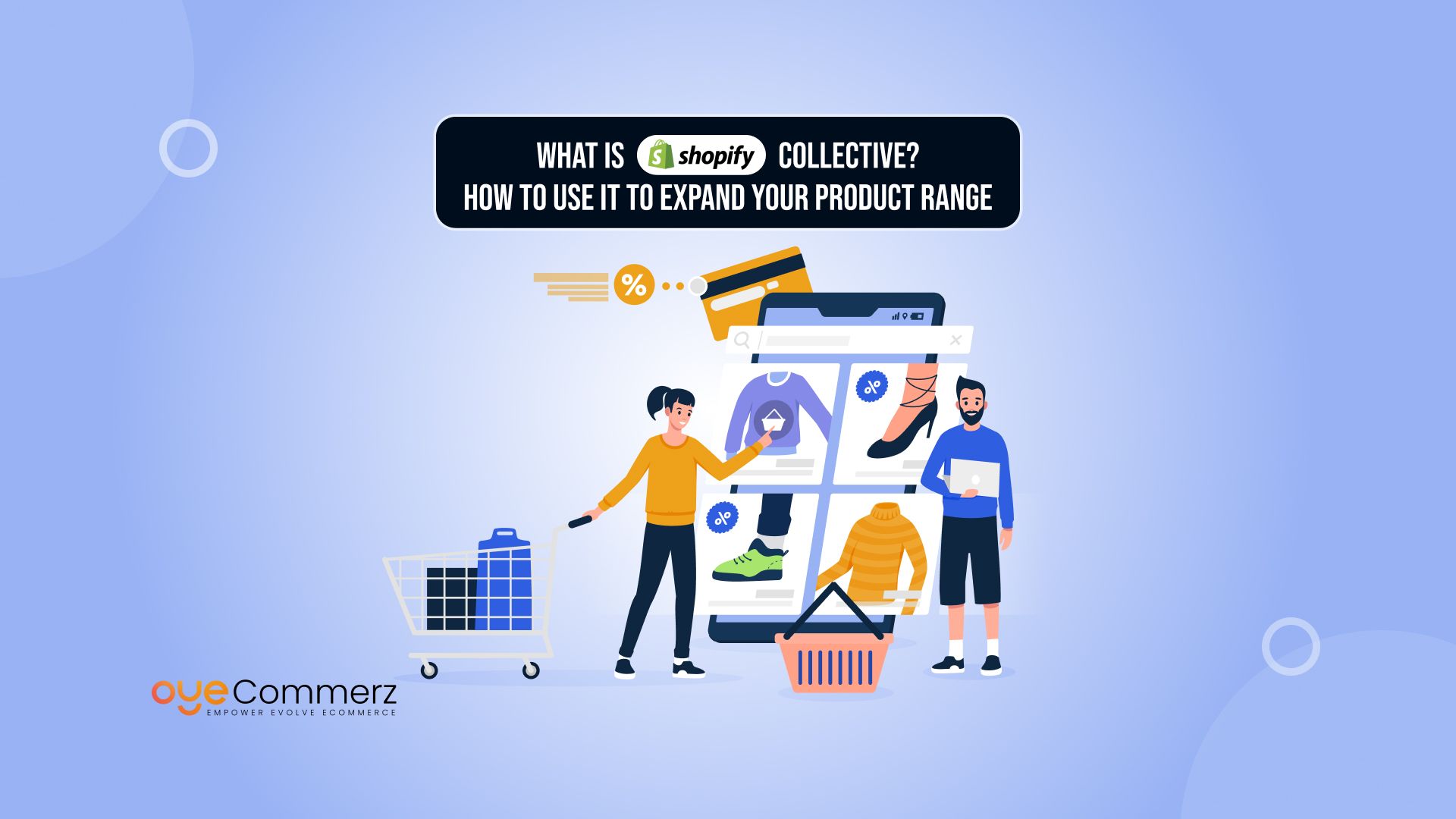Over 70% of online shoppers say they’re more likely to buy from brands that offer a wider variety of products. Have you ever found yourself limited by the products you can offer in your online store? Expanding your product range is one of the most effective ways to stand out in today’s competitive ecommerce landscape, but it’s not without its challenges. From the risks of holding excess stock and tying up capital, to the struggle of finding reliable suppliers, many merchants face significant barriers when trying to grow their offerings.
This is where Shopify Collective comes in. Designed to help ecommerce store owners expand their product catalog without the need for large upfront investments, This allows you to partner with other brands and offer their products in your store. In this blog, we’ll explore what Shopify Collective is, how it can solve these common ecommerce problems, and provide you with a step-by-step guide to use it effectively, helping you boost your product range and grow your business.
Table of Contents
ToggleThe Problem: Why Expanding Product Range is Tough
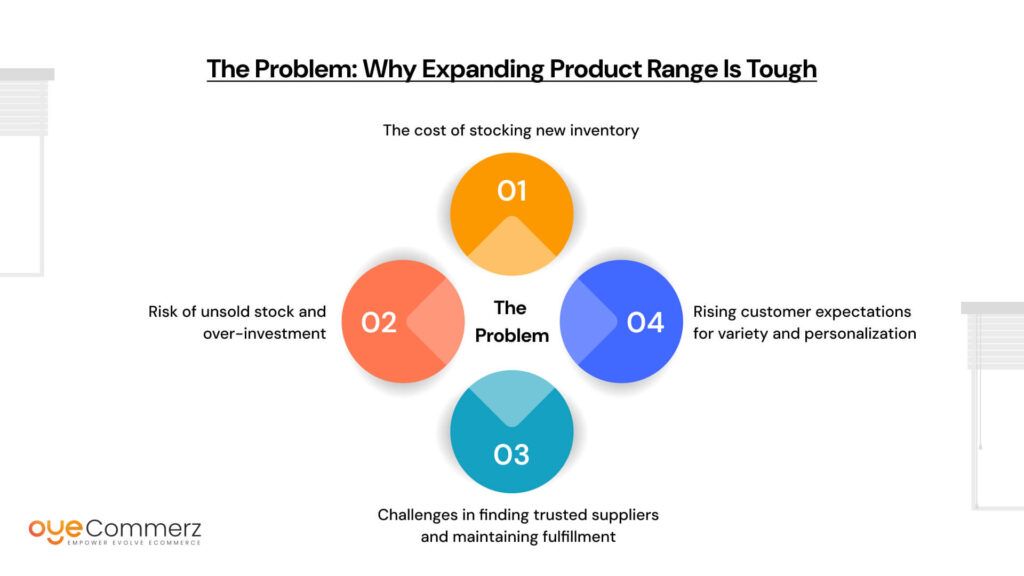
Expanding your product range seems like a great way to attract more customers and increase revenue, but it comes with its own set of challenges. Let’s break down some of the key hurdles merchants face when attempting to diversify their product offerings.
The cost of stocking new inventory
One of the biggest challenges in expanding your product range is the financial commitment required. Stocking new products means investing in inventory upfront. For a small or medium-sized business, this can tie up valuable cash flow and limit your ability to scale. Not only do you need to buy in bulk to secure wholesale prices, but you also have to consider storage costs, packaging, and shipping. For example, a small home décor brand might want to expand into selling furniture, but the financial risk is daunting because of the large inventory costs involved.
Risk of unsold stock and over-investment
The fear of unsold stock is another major concern. If you overestimate demand, you could end up with a lot of unsold products, which not only eats into your profits but could potentially lead to financial loss. This over-investment in inventory is particularly dangerous for businesses with tight margins. Imagine a boutique fashion retailer who orders a wide variety of winter coats but doesn’t sell enough to cover the upfront costs, now they’re stuck with a surplus of stock and no way to move it.
Challenges in finding trusted suppliers and maintaining fulfillment
Finding reliable suppliers can be a daunting task. You need to ensure that the suppliers you partner with maintain consistent product quality, fulfill orders on time, and keep prices competitive. It can take months of research and trial and error to find the right partners, and poor supplier performance can negatively impact your business reputation. A small fitness brand trying to expand its product range might find it difficult to establish a trustworthy relationship with manufacturers of fitness equipment, leading to delays and customer dissatisfaction.
Rising customer expectations for variety and personalization
As consumer expectations rise, shoppers now demand not just more products, but personalized experiences. Customers expect stores to offer tailored recommendations and have a diverse range of items available. A customer may browse through an online clothing store but be disappointed when they don’t find their specific size or preferred style. This pressure forces brands to constantly expand their catalogs and stay on top of trending products. However, keeping up with trends while ensuring the quality of all products can quickly become overwhelming.
Enter Shopify Collective: What Exactly Is It?
Expanding your product range doesn’t have to be complicated or risky, and Shopify Collective is here to make that process seamless. But what exactly is Shopify Collective? Let’s break it down in simple terms.
Official Definition
In its most basic form, It is a platform that enables Shopify merchants to expand their product offerings by connecting with other Shopify brands. You can browse through a network of trusted brands and add their products to your store. It’s an effortless way to offer new products without having to manage the entire supply chain or deal with excess inventory. Essentially, it lets you grow your catalog through a collaborative network of suppliers, all integrated with your existing store.
Key Feature: Connecting with Other Shopify Brands to Sell Their Products
One of the most powerful features is the ability to partner with other merchants in the Shopify ecosystem. Instead of worrying about sourcing new products, you can collaborate with businesses that already have the products you need. This partnership allows you to list and sell their products alongside your own, opening up your store to a wider range of offerings. For instance, if you own a clothing store, you could partner with a local accessories brand and feature their products without ever having to manage the inventory.
How It Works: No Need to Hold Inventory
One of the main advantages is that you don’t have to hold physical inventory. Instead, the product details are listed in your store, and when a customer makes a purchase, the fulfillment is handled directly by the partner brand. This removes the financial risk of overstocking and the logistical challenges of maintaining inventory.This makes it easy for you to diversify your offerings without the upfront investment of traditional inventory-based methods.
Fulfillment Handled by the Partner Brand
The beauty lies in its hands-off fulfillment model. Once a product is sold through your store, the partner brand manages shipping, handling, and returns. You won’t have to worry about storing products or dealing with customer service related to the fulfillment process. This allows you to focus on promoting and growing your brand rather than getting bogged down in operations.
Seamless Integration with Your Existing Store
Shopify Collective integrates effortlessly with your existing Shopify store. You don’t need to overhaul your store or build a new platform to take advantage of the Collective. Once you connect your store to the network, you can start browsing products, adding them to your catalog, and selling them, all within your existing system. This means that there’s no complicated setup, and you can begin expanding your product range almost immediately.
Shopify’s Vision for a Collaborative E Commerce Economy
Shopify envisions a collaborative e-commerce economy where businesses can thrive together. With Shopify Collective, they aim to break down the barriers that typically prevent smaller businesses from offering a wider range of products. Instead of each brand struggling to source everything on their own, it allows for mutually beneficial partnerships, where brands can leverage each other’s strengths and offerings. This collaborative approach makes it easier for brands to scale without the usual risks involved in expansion.
The Power Behind Collective: Why It’s a Game Changer

Expanding your product line used to be a gamble. You’d invest in inventory, worry about where to store it, and hope it sells. Shopify Collective flips this model on its head. It empowers store owners to grow smarter, not harder. Here’s how it becomes a game changer for ecommerce brands of all sizes:
1. Zero Inventory Investment
Traditionally, growing your catalog meant bulk buying products in advance, a costly and risky move. Products from partner brands appear in your store, but the actual stock remains with them. You don’t pay for anything unless it sells.
This not only saves you money but also dramatically lowers the risk of overstocking or sitting on unsold goods.
2. Build Your Catalog Instantly
Expanding your product range used to take weeks or months. Now, it can take hours. It lets you browse other Shopify stores, choose products that align with your brand, and add them with a few clicks.
- No need for sourcing, negotiation, or supplier vetting
- Products are automatically synced with your store, including images, descriptions, and pricing
The result? A full and diverse catalog in record time.
3. Partner with Like-Minded or Complementary Brands
One of the most underrated benefits of Shopify Collective is the ability to choose who you partner with. You can align with brands that reflect your values, audience, and aesthetics. This adds credibility and cohesion to your store while expanding offerings.
For example, a sustainable clothing brand could feature eco-friendly accessories or skincare products from aligned partners.
4. Fast Shipping Through Trusted Shopify Network
When customers shop online, delivery speed matters. Luckily, Shopify Collective’s fulfillment system taps into existing Shopify brands, many of whom already offer quick and reliable shipping.
- Products are shipped directly from the partner’s location
- Trusted fulfillment process ensures happy customers
5. Easier Testing of New Product Lines
Thinking of adding a new category? Try it without the risk. Use Shopify Collective to introduce new products temporarily and test demand.
If your customers love it, great, you scale it. If not, you remove it. No loss on inventory, and real-time customer feedback guides your next steps.
6. Increased Customer Retention Through Variety
A wide range of products keeps customers coming back. Your store becomes a one-stop shop that evolves with your audience’s needs. More variety means fewer reasons for your customers to look elsewhere.
7. Cross-Promotion Opportunities
Partnering with other brands opens doors to cross-promotion. You promote their products, and they promote yours. It’s a win-win for exposure, traffic, and brand growth.
Who Can Use Shopify Collective?
Not every business is eligible to use Shopify Collective, but for the right kind of brand, it can be a powerful tool to expand your product range quickly and smartly. Whether you’re an emerging direct-to-consumer (DTC) label or a well-established niche store, understanding the entry requirements is the first step.
Eligibility Requirements for Merchants and Brands
To start using Shopify Collective, your store must meet a few key conditions:
- Location: Your Shopify store must be based in the United States.
- Plan Level: You need to be on the Shopify, Advanced Shopify, or Shopify Plus plan. It is not available for those on the Starter or Basic plans.
- Platform: You must already be using Shopify, Collective is not compatible with other ecommerce platforms.
If you’re interested in becoming a supplier, that is, having your products sold through other stores, your business must have a reliable fulfillment process and a consistent performance record on Shopify.
Supplier vs. Retailer Roles
It works in two directions:
- Retailers: Add products from other brands to sell in their own store. They manage pricing and presentation, while fulfillment is handled by the partner.
- Suppliers: Allow other Shopify merchants to sell their products and take care of order fulfillment and shipping.
You can act as one or both, depending on your business goals.
Ideal Scenarios for Using Shopify Collective
It is best suited for:
- DTC brands that want to scale without producing more inventory
- Niche ecommerce stores looking to curate thoughtful collections
- Lifestyle brands aiming to provide a fuller customer experience
For example, a skincare brand can expand its product range by adding sustainable beauty tools or wellness supplements from like-minded partners, without stocking any of them.
Step-by-Step: How to Use Shopify Collective to Expand Your Catalog
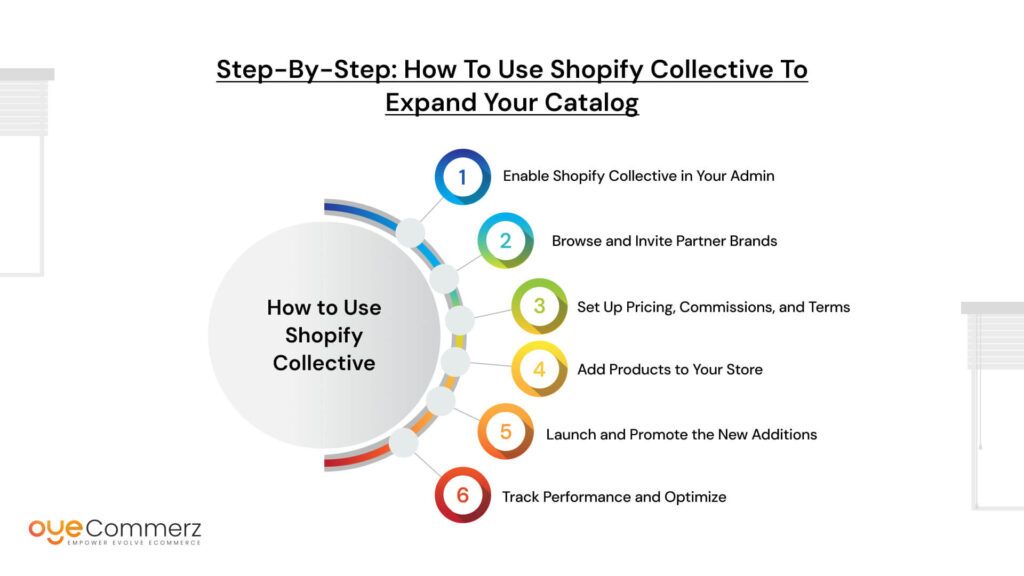
Ready to turn Shopify Collective into a revenue stream? This simple, step-by-step guide will walk you through the full process, from setup to optimization, so you can start offering more products without touching a single box of inventory.
Whether you want to test new product lines, increase customer retention, or strategically expand your product range, these steps will help you make the most of it.
Step 1: Enable Shopify Collective in Your Admin
To begin, head to your Shopify admin dashboard.
- Go to Apps > Shopify App Store
- Search for Shopify Collective and install it
- Once installed, a new tab titled “Collective” will appear in your admin panel
This is your control hub. You’ll manage your partner relationships, imported products, and performance here.
Step 2: Browse and Invite Partner Brands
Inside the Collective dashboard, click on Browse Brands. You’ll see a curated list of Shopify stores that have opted to be suppliers.
- Use filters like category, shipping zones, price range, or brand values (eco-friendly, handmade, etc.)
- Click a brand to explore their catalog
- Press Invite to Connect to send a collaboration request
Once accepted, you gain access to their product listings and terms.
Screenshot-style description: Think of this layout like browsing a marketplace. Each brand profile card shows a short intro, star rating, and bestsellers. Click into any profile to see their full product list and fulfillment timelines.
Step 3: Set Up Pricing, Commissions, and Terms
After a brand accepts your invitation-
- You can set your retail price based on the wholesale price they offer
- Decide your profit margin, Shopify suggests anywhere from 30% to 50%
- Review terms including return policies, fulfillment time, and shipping charges
It makes this seamless by automatically syncing supplier terms into your backend.
Step 4: Add Products to Your Store
Now it’s time to curate your new product range.
- From the accepted supplier’s catalog, select the items that align with your brand
- Click Add to Store and customize each listing—title, product description, variants, and imagery
- Products will appear in your Products tab, just like your original inventory
This is where your brand’s personality comes in. Make sure to rewrite product titles or tweak descriptions to match your store tone.
Step 5: Launch and Promote the New Additions
Once products are live, treat them like your own launch:
- Create a homepage banner or featured collection
- Use email marketing to announce “New Arrivals from Our Collective”
- Run Instagram or Facebook posts with tags like #BrandPartner or #CollectiveDrop
Step 6: Track Performance and Optimize
Within the Analytics section of your Shopify dashboard:
- Filter by product type or tag to monitor Collective product sales
- See which partners drive repeat purchases
- Track conversion rates and average order value changes post-launch
If some items underperform, rotate in new products or experiment with pricing and bundling.
Tools to Elevate the Experience
To boost functionality and customer experience:
- Judge.me or Loox for adding product reviews
- Bold Bundles for creating product sets
- Klaviyo for smart email campaigns promoting new Collective items
Apps like these make your expanded catalog not just bigger, but smarter and more engaging.
How to Choose the Right Brands to Partner With
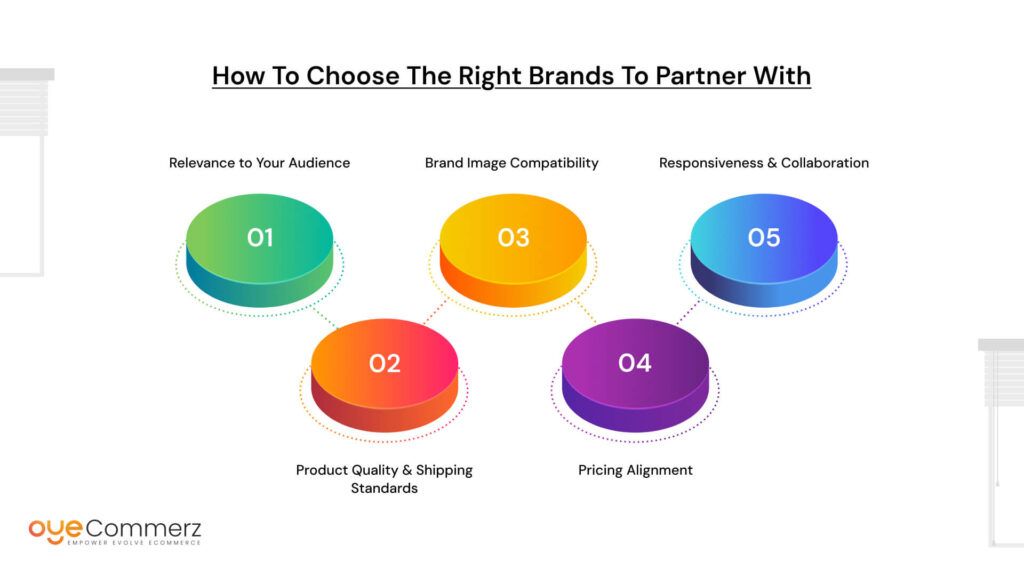
Expanding your store is exciting, but choosing the wrong partners can dilute your brand or disappoint your customers. Smart brand matchmaking is essential to ensure your product catalog grows without compromising trust or quality.
Here’s how to make the right choice:
- Relevance to Your Audience: Look for brands whose products naturally complement yours. For example, if you sell activewear, a partner offering clean protein snacks or gym gear can feel like a seamless addition.
- Product Quality & Shipping Standards: Before adding any product, check their reviews and fulfillment timelines. Your customers will associate delays or poor quality with your store, even if the product is from a partner.
- Brand Image Compatibility: Ensure their tone, aesthetic, and values align with yours. This helps maintain a cohesive experience across your website and marketing channels.
- Pricing Alignment: Partner with brands whose pricing structure allows you to mark up without making products seem overpriced.
- Responsiveness & Collaboration: Communication matters. A partner who’s open, responsive, and proactive will save you time and stress in the long run.
Potential Pitfalls and How to Avoid Them

While Shopify Collective offers powerful benefits, like any tool, it comes with its share of challenges. Being aware of potential pitfalls, and proactively preparing for them, can help ensure a smooth experience for both you and your customers.
Brand Mismatch
One of the biggest mistakes is partnering with a brand that doesn’t align with your values, aesthetic, or customer base. For example, a minimalist skincare brand may clash with a loud, quirky accessories store.
Solution: Vet partner brands thoroughly. Ask yourself, would this product make sense on your shelf if you had a physical store?
Poor Fulfillment by the Partner
Even though you’re not shipping the items yourself, your reputation is still on the line. Delays, damaged packaging, or incorrect items reflect poorly on you.
Solution: Choose brands with high fulfillment standards and positive reviews. Test-order from them to experience the process firsthand.
Customer Confusion Over Delivery or Packaging
Since products are shipped from partner brands, your customers might receive multiple packages or unfamiliar branding.
Solution: Clarify this upfront on product pages. Add a note like: “This item ships directly from our trusted brand partner to ensure faster delivery.”
Unclear Return or Support Processes
Returns can get tricky when you’re not holding the inventory.
Solution: Set clear return policies and SOPs (Standard Operating Procedures). Use templated support responses, and confirm how each brand handles refunds or exchanges.
Pro Tips to Maximize Success with Shopify Collective
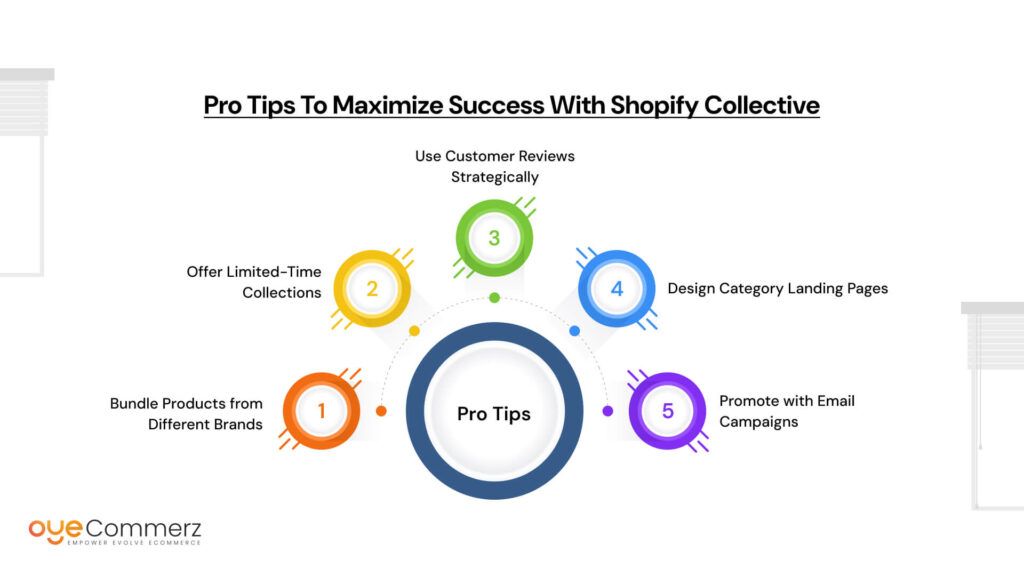
Once you’ve set up Shopify Collective and started adding new products, it’s time to shift gears, from setup to strategy. Here are some practical tips to help you make the most of your expanded catalog and keep your store dynamic and engaging.
- Bundle Products from Different Brands
Create themed bundles using products from your own catalog and partner brands. For example, a “Home Spa Kit” could include your candles and a partner’s skincare items. It adds value for the customer and increases average order value. - Offer Limited-Time Collections
Create seasonal or exclusive collections to add urgency. A “Spring Favorites” range featuring products from various brands can drive short-term spikes in engagement and sales. - Use Customer Reviews Strategically
Track which partner products get positive feedback. Use this data to double down on successful collaborations and reconsider weaker ones. - Design Category Landing Pages
Group your collective items under curated pages like “Shop Our Partners” or “Collaborative Picks” to help shoppers browse seamlessly. - Promote with Email Campaigns
Announce new arrivals from your Shopify Collective partners through emails. Add storytelling around each brand to spark interest and build connections.
These tactics help turn collaboration into a curated customer experience.
Ready to Level Up Your E-commerce Game?
Join thousands of growing brands who trust OyeCommerz to simplify operations, expand product range, and boost conversions.
Start your journey with OyeCommerz today, because your online store deserves more.
Contact to Migrate your Site to Shopify Now
Conclusion
In the ever-evolving world of ecommerce, standing still is not an option. Expanding your product range used to mean taking big financial risks, stocking up on inventory, and hoping it would sell. But with Shopify Collective, that equation changes. It offers a smarter, leaner way to grow, one that removes the heavy lifting of logistics while opening doors to endless possibilities.
This isn’t just another Shopify feature. It’s a real solution to a very real challenge. Whether you’re a niche brand or a lifestyle store, Shopify Collective lets you test new ideas, explore fresh collaborations, and offer more value to your customers, without the capital risk.
The future of ecommerce is not about doing everything alone. It’s about strategic partnerships, shared growth, and customer-first thinking. So don’t wait, start exploring, experimenting, and expanding with confidence. With the right partners, your store can offer more and risk less.
Frequently Asked Questions
Shopify Collective is included with Shopify subscriptions at no extra cost, but standard transaction fees apply.
You need a Shopify store based in the U.S. and be invited or apply via your admin dashboard to use Shopify Collective.
Create a new Shopify store and link it under the same organization using Shopify Plus, or manually manage inventory and branding between stores.
Shopify collections can hold up to 50,000 products, depending on your plan and store setup
Returns are handled by the supplier; buyers follow your return policy, and you coordinate with the supplier for processing.

